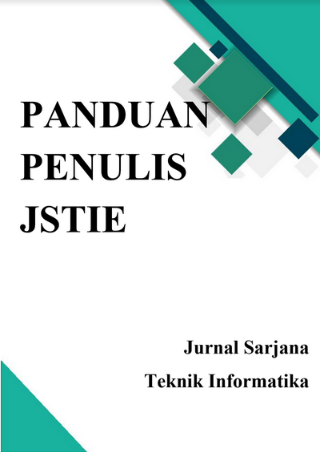VISUALISASI ALGORITMA CHIPER BLOCK CHAINING SEBAGAI MEDIA PEMBELAJARAN BERBASIS MOBILE ANDROID
DOI:
https://doi.org/10.12928/jstie.v2i2.2853Abstract
Kriptografi merupakan salah satu materi utama dalam mata kuliah keamanan komputer. Mata kuliah keamanan komputer merupakan salah satu mata kuliah wajib di program studi teknik informatika, Universitas Ahmad Dahlan, Yogyakarta. Waktu pertemuan dalam perkuliahan keamanan komputer sesuai dengan satuan perkuliahan (SAP) hanya 14 kali pertemuan. Metode-metode kriptografi yang dibahas sangat banyak, diantaranya metode Chiper Block Chaining. Pembahasan Metode kriptografi ini tidak dibahas secara mendetail hanya dibahas 1 kali pertemuan saja. Jadi tidak memungkinkan mahasiswa mampu memahami tentang algoritma metode kriptografi tersebut secara mendetail di kelas.
Subjek peneltian ini adalah merancang suatu proses visualisasi proses enkripsi dan dekripsi untuk mendukung proses pembelajaran kriptografi, metode yang digunakan dalam proses enkripsi dan dekripsi adalah metode Chiper Block Chaining. Langkah pengembangan aplikasi diawali dengan pengumpulan data dari banyaknya mahasiswa yang menggunakan smartphone berbasis android dilanjutkan dengan studi pustaka dan mengamati program-program kriptografi. Merancang tampilan aplikasi dan mengimplementasikan hasil rancangan menjadi sebuah program. Melakukan pengujian program dengan blackbox test dan alpha test.
Dalam penelitian yang dilakukan dihasilkan sebuah perangkat lunak visualisasi Chiper Block Chaining yang dikemas dalam bentuk aplikasi yang berbasis android, program enkripsi dan dekripsi karakter teks menggunakan bahasa pemrograman android yang berbasis java, hasil ujicoba yang telah dilakukan menunjukan bahwa aplikasi ini sudah layak dan dapat dimanfaatkan.
Â
Kata kunci      :Security Computer, Kriptografi, Chiper Block Chining, Android, VisualisasiReferences
Andypal, Prana, 2011, “Simulasi Proses Enkripsi Dan Dekripsi Algoritma Rijndael Untuk Mendukung Proses Pembelajaran Kriptografi Berbais Webâ€, Teknik Informatika Universitas Ahmad Dahlan.
Kurniawan, Heru, 2013, “Visualisasi Proses Enkripsi Dan Dekripsi Metode AADFGVX PRODUCT CHIPER DAN CHIPER BLOCK CHAININGâ€, Teknik Informatika Universitas Ahmad Dahlan.
Munir, Rinaldi, 2006, “Kriptografiâ€, Informatika, Bandung.
Wikipedia, 2005, “Multimediaâ€, http://id.wikipedia.org/wiki/Multimedia. 17 Desember 2013.
Wikipedia, 2009, “Android (sistem operasi)â€, http://id.wikipedia.org/wiki/Android. 17 Oktober 2013.
Yuliana, Rahmawati, 2008, “Visualisasi alat bantu pembelajaran kriptgrafi asimetris RSA (Rishet Shamir Adleman)â€, Teknik Informatika Universitas Ahmad Dahlan.
Downloads
Published
Issue
Section
License
License and Copyright Agreement
In submitting the manuscript to the journal, the authors certify that:
- They are authorized by their co-authors to enter into these arrangements.
- The work described has not been formally published before, except in the form of an abstract or as part of a published lecture, review, thesis, or overlay journal. Please also carefully read Journal Posting Your Article Policy.
- The work is not under consideration for publication elsewhere.
- The work has been approved by all the author(s) and by the responsible authorities – tacitly or explicitly – of the institutes where the work has been carried out.
- They secure the right to reproduce any material that has already been published or copyrighted elsewhere.
- They agree to the following license and copyright agreement.
Copyright
Authors who publish with Jurnal Sarjana Teknik Informatika agree to the following terms:
- Authors retain copyright and grant the journal right of first publication with the work simultaneously licensed under a Creative Commons Attribution License (CC BY-SA 4.0) that allows others to share the work with an acknowledgement of the work's authorship and initial publication in this journal.
- Authors are able to enter into separate, additional contractual arrangements for the non-exclusive distribution of the journal's published version of the work (e.g., post it to an institutional repository or publish it in a book), with an acknowledgement of its initial publication in this journal.
- Authors are permitted and encouraged to post their work online (e.g., in institutional repositories or on their website) prior to and during the submission process, as it can lead to productive exchanges, as well as earlier and greater citation of published work.







